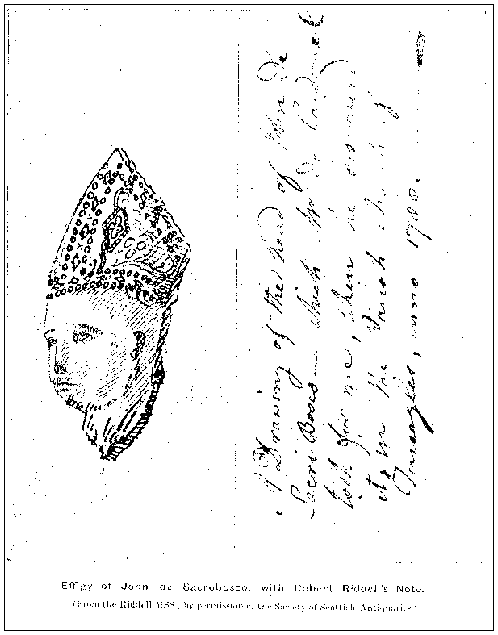John of Holywood?
Johannes or Ioannes de Sacrobosco or Sacrobusco (John of Holywood), the author of a handful of widely read medieval texts on mathematics and astronomy, may have been an abbot of Holywood. Yet only the faintest sense of his life can be inferred; most details are speculation. Nearly all published details are, in fact, errors either invented, interpolated or propagated by commentators and authors from the Middle Ages, to eighteenth and nineteenth century antiquarians, to uncritical modern compilers.

An 18th century sketch of a statue seen in Terregles church, reputed to be of John of Holywood. 'Revirosco' states that the statue was recovered from the abbey at the Reformation and taken for safekeeping to Terregles church. The shape of the mitre hints at a date for the statue from the 15th century onwards, which would be too late to link with Sacrobosco [Braun, J. (1911). Mitre. In The Catholic Encyclopedia. New York: Robert Appleton Company]

1811 sketch of the same statue, by then located at Friar's Carse estate, attributed to Dr Robert Clapperton and collected by George Henry Hutton [SCRAN, Hutton Collection, (c) National Library of Scotland; for educational use only].
For hundreds of years his name was a household word to any student of the liberal arts. The seven artes liberales included grammar, rhetoric and logic (the trivium) and arithmetic, geometry, astronomy and music (the quadrivium). Sacrobosco's book De Sphaera was the standard manual for learning elementary astronomy for a dozen generations of scholars from the mid 12th century to the Renaissance. The work, only 9000 words long, described a spherical Earth some two centuries before Columbus. It dealt also with the general structure of the universe, the circles of the celestial sphere, phenomena caused by the daily rotation of the heavens around the earth, and planetary motion and causes of eclipses. The original text, probably written around 1231, was hand-copied for over two centuries by a succession of scribes, and the first printed edition appeared in 1471. From that time it was reprinted 35 times in Venice up till 1620, and an equal number of times at Paris between 1494 and 1620. Editions also were printed at Cologne, Basel, Leiden, Antwerp, Wittenberg, Bologna, Milano, Avignon, Dijon, Louvain, Frankfurt, Vienna, Augsburg and Cracow.
There are few clues concerning the life of John of Holywood. In 1271 a commentator on the Sphere named Robertus Anglicus wrote, from somewhere in France, that its author was "Johannes de Sacrobosco Anglicus" or "The Englishman John of Holywood". As Robertus was himself English, and was writing a few decades after Sacrobosco's works seem to have been written, it seems plausible that Sacrobosco was indeed English or at least from the island of Britain.
Authors writing in the 16th century began to speculate on the national origins of Sacrobosco. Three claims were made and propagated: that he was from Halifax, England; from Holywood, Ireland; or from Holywood, Scotland. The Halifax claim seems unlikely, as 'Halifax' is not a reasonable translation of 'Sacrobosco' (its Saxon origin, in fact, means 'Holy Hair').
Similarly, the first claim of an Irish origin for Sacrobosco is from the 1577 text by Richard Stanyhurst, Description of Irelande. Holywood was a common place name in Ireland.
The third claim, that Ioannes Sacrobosco was from Holywood in Nithsdale (i.e. the location of the later Holywood Village, near Dumfries) has greater plausibility. The important 12th century Premonstratensian abbey was referred to in Latin documents as Sacro Bosco or Sacri Nemoris, apparently the only place in the British isles to have this name. On the other hand, medieval authors would have been likely to use the term Scotus rather than Anglicus to denote Scottish origins. However, scholars studying in Paris from the British Isles (as Sacrobosco is thought to have done), Scandinavia or Germany would normally have joined the Natio Anglicana or 'English Nation', a grouping akin to a student's union.
From indirect evidence and some unverifiable claims, it appears that Sacrobosco may have been a monk at Holywood for some years (perhaps until his mid-twenties) and then gone to teach at the university of Paris in 1221. His students were mostly in their teens, and were studying newly-translated works of Greek science -- Euclid, Apollonius, Ptolemy and Aristotle -- based on Arabic translations. This may partly explain the success of Sacrobosco's works, which were not dramatically novel. Their appeal lay in their clarity, which was likely gained by his teaching young students with relatively blank minds. Sacrobosco's works were also among the first to clearly explain arabic arithmetic to the medieval European world, and to describe the history of ancient Greek, Roman, Hebrew and Arab systems of time.
There is strong evidence from late 18th century sources that the grave of Johannes de Sacrobosco was in the cloisters of the monastery of Saint-Mathurin in Paris (the headquarters of the University of Paris), and included an engraving of an astronomical instrument or inscribed sphere. The inscription on the grave commemorates "de Sacrobosco qui computista Joannes", an expert on time-reckoning who 'sorted out' the different aspects of time. His most extensive work, in fact, dealt with the calendar and calendar reform.
The grave can no longer be located, and the year of his death is uncertain, although likely before 1276. From the 17th century onward, Sacrobosco's works ceased to be part of the 'scientific' component of the liberal arts curriculum. He is remembered today principally by medieval historians and historians of science.
A large fraction of this text was loosely adapted from Olaf Pederson, 'In Quest of Sacrobosco', Journal of the History of Astronomy 16 (1985), pp. 175-221.